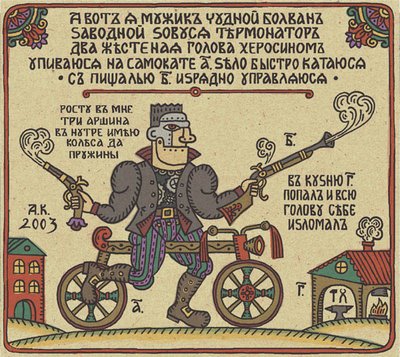 Modern movies as folk prints - woodcut images in the Russian Lubok folk art tradition. Requires more in the way of interpretation than translation. [via MonkeyFilter]
Modern movies as folk prints - woodcut images in the Russian Lubok folk art tradition. Requires more in the way of interpretation than translation. [via MonkeyFilter]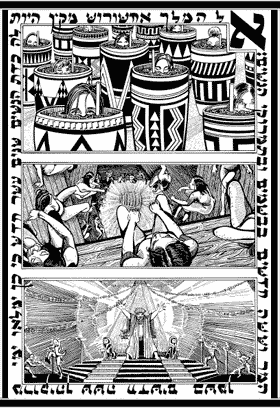 Megillat Esther : The Book of Esther from the Tanakh (Jewish Bible)
Megillat Esther : The Book of Esther from the Tanakh (Jewish Bible)and Old Testament refashioned as a graphic novel. [via Menachem Mendel]
Somewhere in the University of Bielefeld.
 From the 2nd edition of 'New Zealand Birds and How to Identify Them'
From the 2nd edition of 'New Zealand Birds and How to Identify Them'by Perrine Moncrieff (first published 1925) at Glyph Jockey.
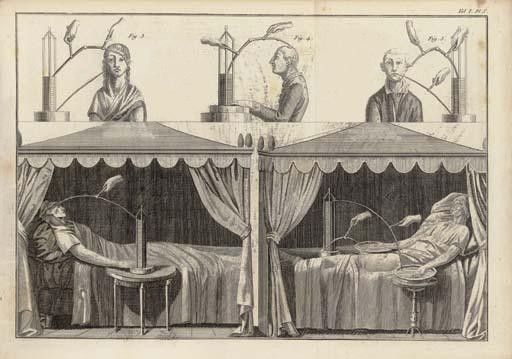 Although they don't have large images, the Christies Auction site is a veritable smorgasbord for rare printed material. I seem to recall the above image, snagged at random, has something to do with galvanometry or human electricity or the somesuch. [Of particular note: 'The History of the Book: The Cornelius J. Hauck Collection' - auction next week. Drool.]
Although they don't have large images, the Christies Auction site is a veritable smorgasbord for rare printed material. I seem to recall the above image, snagged at random, has something to do with galvanometry or human electricity or the somesuch. [Of particular note: 'The History of the Book: The Cornelius J. Hauck Collection' - auction next week. Drool.] "Indonesian Batak Pustaha - Detail from nineteenth century magic
"Indonesian Batak Pustaha - Detail from nineteenth century magicbook, written on bark from the alim tree and used by medicine-men
in performing ceremonies. Folded in concertina fashion."
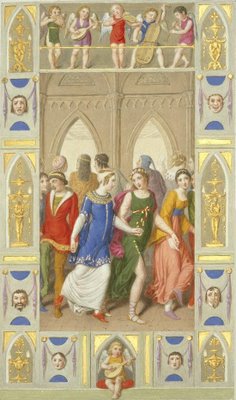
 The above 2 images are taken from an 1819 edition of
The above 2 images are taken from an 1819 edition of'Giulietta e Romeo' by Luigi Da Porto
(originally published sometime before 1529 - this is the book
that Shakespeare's Romeo and Juliet is based on)
 'Lud Hurdibras, Bladud and King Leir (Lear)' from:
'Lud Hurdibras, Bladud and King Leir (Lear)' from:'Genealogy and Race of all the Kings of England' 1562 by Giles Godet.
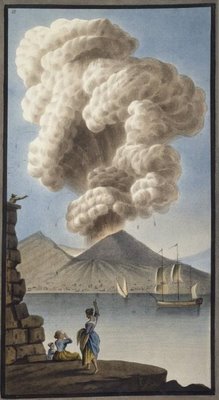 This painting is found in Sir William Hamilton's 'Campi Phlegraei, Observation on the volcanos of the two Sicilies As they have been communicated to the Royal Society of London' 1779. The image is one of 5 supplementary plates Hamilton included as an appendix to his vulcanology book following the eruption of Mount Vesuvius in Naples in 1779. More here, here and here.
This painting is found in Sir William Hamilton's 'Campi Phlegraei, Observation on the volcanos of the two Sicilies As they have been communicated to the Royal Society of London' 1779. The image is one of 5 supplementary plates Hamilton included as an appendix to his vulcanology book following the eruption of Mount Vesuvius in Naples in 1779. More here, here and here. An original pen/ink drawing -- 'Rocking Stones' --
An original pen/ink drawing -- 'Rocking Stones' --from 'Antiquarian Notes' 1789 by Dorothy Richardson.
It is a depiction of Logan Stones in Cornwall.
All the images from the Claxton Printers device onwards come from the excellent Rylands Collection at the University of Manchester. I've posted some alchemy images previously but there are more than 2,500 rare book images available. The bad news is that you must install the Insight™ Browser (not so bad). All of the above Rylands Collection images are made from spliced screen captures. They have an amazing and eclectic set of works - one of the best online UK repositories - and I still haven't been through them all.
=========================================
For those who read this site via an RSS feed, the BibliOdyssey sidebar is guaranteed to contain high fibre, low cholesterol digital comfort food:
::wood s lot::, Giornale Nuovo, Carolina Vigna-Marú, i like, RaShOmoN, Spiderblog, Blog With a View, Earmarks, boynton, Plep, Agence Eureka, Early Modern Notes, andreaxmas, Modern Mechanix, dirtybeloved, Bibi's Box, Carnet de Zénon, neurasthenia, Languagehat, Illustration Art, blanketfort, The Maproom, Coudal, \\Ursi//, Pruned, Philobiblon Book Arts, Lines and Colors, BookLust, things magazine, the nonist, Jaf Project, Incoming Signals, eyebeamR, Points of Departure, Drawn!, Eastern Blot, Spy's Spice, Sarsaparilla, Netlex News, ~Tiny Bubbles~, Psychick Blah, The Stingy Scholar, Malanda, Sarsaparilla, Philobiblon (History), Ramage, gmtPlus9(-15) - arranged in order of 'dart affinity'. Pants are optional.























8 comments :
what does dart affinity mean?
Answer A:
Take 1 dart.
Spin around three times at speed.
Throw dart.
Whichever website is hit first has the highest affinity for the dart.
Rinse & repeat.
-------------------
Answer B:
There is no dart.
I like!
Thanks for making me feel ignorant... again.
A tasteful execution! That's exactly what this site needs.
great blog, I've been looking for something like this
here's a link on origin of the first picture (in Russian Lubok style):
http://www.hiero.ru/Akuaku/Lubki
author's name is Andrey Kuznetsov.
and you're right, it's really difficult to find proper translation. he used old, or looks-like-old words. all of them are recognized by modern reader and fit good for his graphic style: funny and clever stylization of Lubok pictures on nowadays reality.
e.g. on this picture you can see Terminator, "strange man, clockwork blockhead"... all these texts are rhymed, as it often was on Lubok pictures.
and on ziza.ru it's just copy-paste.
Thanks daubmanus, I love Kuznetsov's work and it's even better to know that it was a parody on the Lubok verses too!
Post a Comment
Comments are all moderated so don't waste your time spamming: they will never show up.
If you include ANY links that aren't pertinent to the blog post or discussion they will be deleted and a rash will break out in your underwear.
Also: please play the ball and not the person.
Note: only a member of this blog may post a comment.